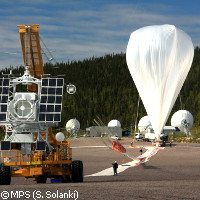Sunrise in Sweden: solar observatory launched in helium balloon
On 8 June, the solar observatory Sunrise was launched from the Esrange Space Centre in Kiruna, Sweden. A gigantic helium balloon, carrying approximately 1 million cubic metres of gas, is now carrying the largest solar telescope ever to lift off from the Earth's surface. The observatory will circle the North Pole, where the Sun never sets in summer. There, it is expected to gather highly accurate information about the magnetic fields of the Sun's atmosphere. Over the next few days, the balloon will monitor the Sun non-stop as the polar winds carry it westwards over the northern Atlantic Ocean, Greenland and Canada at an altitude of 37km above sea level. One of the main advantages of the Sunrise observatory is that it will be able to function in the stratosphere (the layer of the atmosphere between 10km and 50km above the Earth's surface), beyond Earth's more turbulent lower atmosphere. 'Not only the balloon makes Sunrise special,' said Peter Barthol of the Max Planck Institute for Solar System Research in Germany. The scientists also believe that Sunrise will be able to observe the Sun's surface with an accuracy that has so far been unattainable using Earth-bound telescopes and space probes. 'We expect Sunrise to allow us to discern the finely structured surface of the Sun and the distribution of [its] magnetic fields with a resolution of up to 35 kilometres,' added Sami Solanki, leader of the Sunrise mission. The resolution offered by the telescope, the researchers explained, is equivalent to seeing a one-euro coin from a distance of 100 km. The light-weight telescope has a mirror measuring one metre in diameter. The Sunrise 'gondola' is also fitted with a number of systems to adjust and stabilise the optical instrument during the flight: (including a high-speed 'steering mirror'); a Sunrise Polarimetric Spectrograph (SUPOS) for high-precision, spectral-line measurements in the polarised light; a Sunrise Filter Imager (SUFI) for high-resolution images in the visible and ultraviolet (UV) spectral ranges; and a magnetograph (dubbed 'IMaX') that provides two-dimensional maps of the complete solar magnetic field vector. The observatory is also fitted with solar panels, ballast and crash pads for landing. Sunrise travelled through the tropopause (the boundary, at around 10km above sea level, between the troposphere and the stratosphere) at about 15 kilometres per hour. The device is subjected to very cold temperatures (about -45°C). To protect the equipment, a special protective cover was constructed using a polyethylene film that protects the instruments from cold while still allowing them to let off heat. The scientists monitoring data from Sunrise will focus on gathering information about the fine structure and dynamics of the magnetic field in the solar atmosphere. This will help them gain valuable insights into solar phenomena including sunspots and solar winds. According to the project's leaders, 'The magnetic field is the source of solar activity; [it] controls the space environment of the Earth and causes the variability of solar irradiance, which may be a significant driver of long-term changes of the terrestrial climate'. They explain that the magnetic field in the solar photosphere develops intense field concentrations, which are crucial for the dynamics and energetics of the whole solar atmosphere. 'These spatial scales cannot be studied systematically from the ground because of image distortion by turbulence in the lower atmosphere of the Earth,' the researchers say. 'The balloon-borne Sunrise telescope will, for the first time, provide measurements of the magnetic structure of the solar atmosphere on its intrinsic spatial and temporal scales.' In its first hours of flight, the observatory transmitted data back to the Esrange Space Centre. For the rest of its mission, it will save data onboard for later analysis. At the end of this week, a parachute will carry Sunrise back to Earth in northern Canada. Preparations for this week's mission have been underway for the past six years. This is the first of a series of stratospheric balloon flights in which the observatory will collect data so that the researchers can study the UV spectral region down to 220 nanometres. Such resolution is not currently attainable using ground-based instruments. The project partners hope that the Sunrise missions will enable the observatory to become 'the central element of a future space-borne solar observatory'. Sunrise partners, led by the Max Planck Institute for Solar System Research in Germany, include the Kiepenheuer Institute for Solar Physics in Freiburg in Germany, the Instituto de Astrofisica de Canarias in Spain, as well as the High Altitude Observatory, the Lockheed-Martin Solar and Astrophysics Laboratory and the NASA Columbia Scientific Ballooning Facility in the US.
Countries
Germany, Sweden, United States



